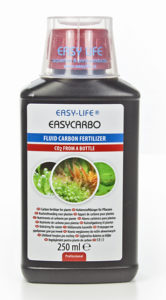
Use of liquid carbon in an aquarium
“Liquid CO2” or “liquid carbon” is a liquid (naturally) that is advertised to provide a usable and growth-impactful source of carbon to submerged plants. Although it’s hard to get definitive component analysis, liquid carbon is inevitably either glutaraldehyde, or a derivative form of glutaraldehyde e.g. a cyclised stabilised variant. Popular brands of liquid carbon include EasyCarbo from Easy-Life (which is what I use) and Flourish Excel from Seachem. Whether liquid carbon actually improves aquatic plant growth, and if so how, is a subject of considerable debate.
The usual marketing argument for liquid carbon generally goes that the carbon-containing glutaraldehyde molecules in the liquid carbon, whilst not themselves directly usable as a carbon source by plants, can be converted by aerobic bacteria into molecules which can be taken up and used metabolically by plants. It is difficult to get to either the truth or falsity of this argument. That being said, if plants could usefully take up soluble carbon source molecules derived from glutaraldehyde, then why not simply provide those molecules directly as “liquid carbon” rather than requiring some mysterious bacterial metabolic process on glutaraldehyde? Glutaraldehyde has a reputation as being a toxic hospital disinfectant (which is true) so use in aquariums has been hugely controversial – mostly the controversy is overblown as there is a wide dosing safety margin for liquid carbon when used according to the label and “toxic when used in excess” applies to just about anything.
Liquid carbon is not a substitute for injected CO2 gas
Whilst it could be debated as to whether use of liquid carbon improves plant growth in aquaria, and the above metabolic intermediates derived from glutaraldehyde argument notwithstanding, it is reasonably definitive that liquid carbon is not converted to meaningful levels of actual carbon dioxide in the water column. The concentation of dissolved carbon dioxide is easily and accurately measured using a drop checker. The drop checker is a blue colour when CO2 levels are too low, green when they are right and yellow when they are too high. Despite careful observation, I have never seen liquid carbon affect the colour of a drop checker, and nor has anyone else near as I can tell. You’ll never get your drop checker to shift from blue to green using liquid carbon. If that’s what you’re after you have to inject CO2 gas directly.
Liquid carbon is useful as an algaecide
Glutaraldehyde, consistent with its disinfectant properties, is a known algaecide. Usefully, algae is (in general) more sensitive to glutaraldedhyde toxicity than are plants, fish, shrimp, snails and other desireable residents of an aquarium. This means if you can get the “liquid carbon” concentration right, you can suppress algae growth. Indirectly, algae suppression can benefit plant growth, both because the algae will no longer be competing with plants for nutrients, and because algae tends to grow on upper plant leaf surfaces where it competes for light. When this doesn’t happen, plants grow better. I use liquid carbon regularly, and algae suppression is the reason why. I use 1 ml liquid carbon every day* in my 45 L tank.
Spot treating algae with liquid carbon
Spot treatment with undiluted liquid carbon is an excellent method for solving localised algae problems. Use the undiluted form by dropwise addition directly onto hardscape surfaces with problematic algae only – do not use the undiluted form on aquarium plants or livestock, and there is no need to treat surfaces that don’t have an algae problem. The EasyCarbo has a certain viscosity to it which allows it to do a good job of spreading over and adsorbing onto algae patches. Adding an algae spot-treatment step during your regular water change routine is easy and effective. Since I’m using estimative index fertilizers, I change out 50% of the water weekly. After removing the water the surfaces of the hardscape components of the aquarium closest to the light, where the algae grows most vigorously, are exposed. On water change days I measure out 1.5 ml liquid carbon and spot treat that around on those surfaces, leaving the liquid carbon on for 5 or 10 minutes to give it time to work. When the new water is added back, the concentration of the liquid carbon reverts to about where you’d like it to be systemically**. This spot treatment has been particularly effective in clearing the algae from the central bubble tube of the aquarium, which otherwise can be very problematic to clean out. Liquid carbon also works brilliantly to clear up scuzzy CO2 diffusers! The effect is not instantaneous, rather you’ll notice the algae gradually die over the next several days following spot-treatment.
*Whilst I love the effectiveness of liquid carbon as an algae spot-treatment method I have lately started to wonder whether the daily use directly into the water column is really needed.
**You can comfortably use double the amount of liquid carbon recommended for regular use if necessary with no adverse effects.